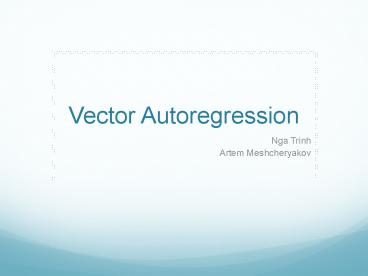Vector Autoregression - PowerPoint PPT Presentation
1 / 19
Title:
Vector Autoregression
Description:
Vector Autoregression Nga Trinh Artem Meshcheryakov Overview Vector Autoregression (VAR) model is an extension of univariate autoregression model to multivariate time ... – PowerPoint PPT presentation
Number of Views:3218
Avg rating:3.0/5.0
Title: Vector Autoregression
1
Vector Autoregression
- Nga Trinh
- Artem Meshcheryakov
2
Overview
- Vector Autoregression (VAR) model is an extension
of univariate autoregression model to
multivariate time series data - VAR model is a multi-equation system where all
the variables are treated as endogenous - There is one equation for each variable as
dependent variable. Right-hand side of each
equation includes lagged values of all dependent
variables in the system, no contemporaneous
variables
3
VAR Model
- VAR(p) model
- Yt A B1Yt-1 B2Yt-2 BpYt-p et
- where
- Yt (y1t, y2t, , ynt) an (nx1) vector of
time series variables - A an (nx1) vector of intercepts
- Bi (i1, 2, , p) (nxn) coefficient matrices
- et an (nx1) vector of unobservable i.i.d.
zero mean error term (white noise)
4
VAR Model
- Example Bivariate VAR(2) model
- Or
- y1t a1 b111y1t-1 b112y2t-1 b211y1t-2
b212y2t-2 e1t - y2t a2 b121y1t-1 b122y2t-1 b221y1t-2
b222y2t-2 e2t
5
Why do we need VAR?
- Time-series data with autoregressive nature
(serially correlated) - VAR model is one of the most successful and
flexible models for the analysis of multivariate
time series - Especially useful for describing the dynamic
behavior of economic and financial time series - Useful for forecasting
6
Applications of VAR
- Analysis of system response to different
shocks/impacts - Model-based forecast. In general VAR encompasses
correlation information of the observed data and
use this correlation information to forecast
future movements or changes of the variable of
interest
7
Applications of VAR
- In economics, VAR is used to forecast
macroeconomic variables, such as GDP, money
supply, and unemployment - In finance, predict spot prices and future prices
of securities foreign exchange rates across
markets
8
Applications of VAR
- In accounting, predict different accounting
variables such as sales, earnings, and accruals - In marketing, VAR can be used to evaluate the
impact of different factors on consumer behavior
and forecast its future change.
9
Applications of VAR Forecasting
- 1-step forecast based on information available at
time T - YT1T A B1YT B2YT-1 BpYT-p1
- h-step forecast
- YThT A B1YTh-1T B2YTh-2T
BpYTh-pT
10
Implementation
- All data have to have same frequency
- Data with mixed frequency need to be converted to
the same frequency - Convert higher-frequency data to the frequency of
the lowest-frequency data). For example if we
have daily, weekly and monthly data then we will
need to convert everything to monthly frequency - Interpolate lower-frequency data into high
frequency
11
Example of VAR usage
- Testable hypothesis there has to be a dependence
of DJIA index on its own lag and on lag of total
market capitalization and vice versa - Use return on DJIA index and return on market
capitalization - Monthly observation
12
Dataset
- Obs year
month ret_dji ret_totval - 1 1961 1 . .
- 2 1961 2 0.02619 0.032994
- 3 1961 3 0.02575 0.033013
- 4 1961 4 0.01442 0.006127
- 5 1961 5 0.02067 0.022185
- 6 1961 6 -0.02172 -0.030350
- 7 1961 7 0.01913 0.033709
- 8 1961 8 0.03243 0.022871
- 9 1961 9 -0.03279 -0.020618
13
SAS Implementation
- PROC VARMAX
- proc varmax datacomb
- model ret_dji ret_totval / p1
- run
- ret_djit a1 b11 ret_djit-1 b12
ret_totvalt-1 e1t - ret_totvalt a2 b21 ret_djit-1 b22
ret_totvalt-1 e2t
14
SAS Output
Ret_djit 0.005 0.298 ret_djit-1 0.378
ret_totvalt-1 e1t Ret_totvalt 0.008 0.067
ret_djit-1 0.048 ret_totvalt-1 e2t
15
SAS Output
16
Concerns
- Assuming all variables are endogenous
- If time-series data are nonstationary (containing
stochastic trends), while it is possible to
estimate VAR in levels, it is preferable to
estimate VAR in first differences - Uncertainty about number of lags (using LR test,
Information criteria AIC, BIC etc.)
17
Concerns
- Data requirements (long time series)
- Imprecise estimated coefficients (overfitting the
model). Solution restrict or weight
coefficients - Computationally intensive
18
References
- Chapter 1 Vector Autoregressions.
https//www2.bc.edu/iacoviel/teach/0809/EC751_fil
es/var.pdf - Chapter 6 Multivariate time series models.
www.nek.lu.se/.../Ch620Multivariate20time20seri
es20models - Chapter 11 Vector Autoregressive Models for
Multivariate Time Series. http//faculty.washingto
n.edu/ezivot/econ584/notes/varModels.pdf
19
References
- Dwyer, Gerald P., Jr. Why Are Vector
Autoregressions Useful in Finance?
http//jerrydwyer.com/pdf/lectvar.pdf - Vector Autoregressions Forecasting and
Reality.http//www.frbatlanta.org/filelegacydocs/r
obtallman.pdf































